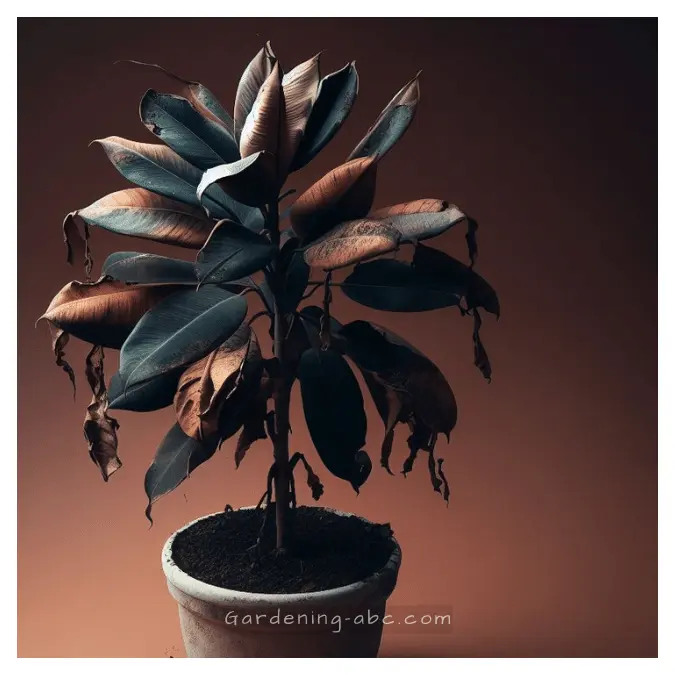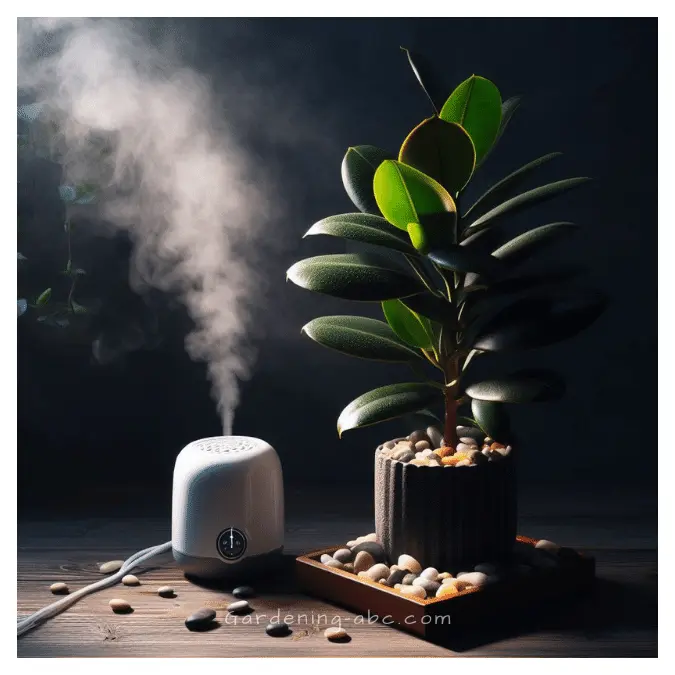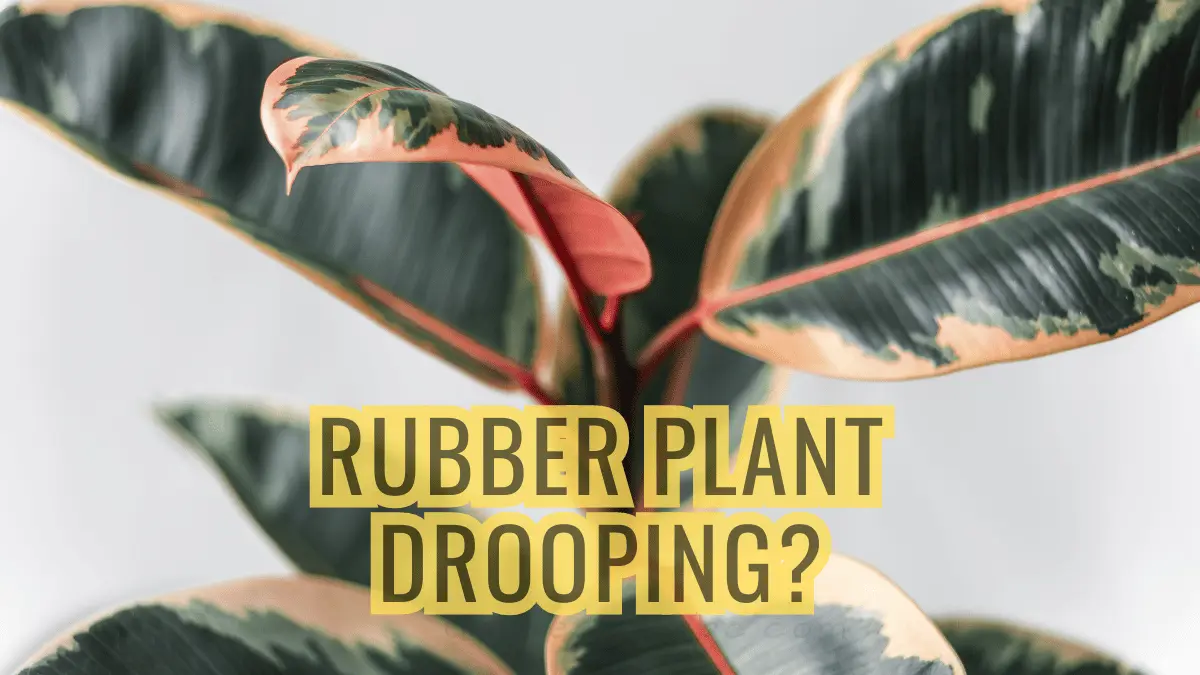We use affiliate links to run our site. When you buy through links on our site, we may earn an affiliate commission, without any added cost to you. Learn more
So you went and got yourself a nice rubber plant to liven up your living space. Everything was going great until one day you noticed the leaves starting to droop and wilt. Now your once-vibrant rubber plant looks sad and limp. What gives?
Don’t worry, droopy leaves on a rubber plant are common and usually an easy fix. In this post, we’ll go over the top reasons your rubber plant leaves are drooping and how to perk them back up.
Common Causes of Drooping Rubber Plant (Ficus elastica) Leaves
There are a few key things that typically cause rubber plant leaves to go limp and lose their perkiness. Here are some of the most common culprits:
| Reason | Description | Solutions |
|---|---|---|
| Overwatering | Excess water in soil reduces oxygen, causing root death and wilting leaves. | – Ensure the pot has a drainage hole. – Use free-draining soil. – Reduce watering in the cold season. |
| Underwatering | Insufficient soil moisture leads to leaf dehydration and drooping. | – Water thoroughly when dry. – Maintain soil moisture in the growing season. – Avoid completly drying out. |
| unusually Hot Temperature | High temperatures result in excessive water loss from leaves, causing wilting. | – Protect from hot draughts. – Maintain room temperature within 15-28°C range. |
| Low Humidity | Insufficient humidity causes leaf dehydration and loss of turgidity. | – Use a wet pebble tray or humidifier. – Place in humid areas with adequate light. |
| Not Enough Light | Inadequate light reduces food production, leading to energy-saving wilting. | – Move to a brighter spot with direct sunlight. – Clean leaves for better photosynthesis. |
| Overfertilizing | Excessive fertilization causes root death and inability to take up water. | – Feed monthly with a balanced fertilizer. – Flush soil to remove excess salts. |
| Accumulation of Salts | High soil salt concentration prevents water uptake by roots, causing wilting. | – Regularly flush out salts from the soil. |
| Under fertilizing | Lack of nutrients in actively growing tips leads to nutrient withdrawal from leaves. | – Feed monthly with balanced liquid fertilizer. |
| Pest Infestations | Pests like aphids and mealybugs dehydrate the plant, resulting in wilting leaves. | – Inspect and treat for pests. – Maintain leaf cleanliness and humidity. |
| Root-rot Disease | Soggy soil causes root rot, leading to root death and wilting leaves. | – Trim affected roots, repot in fresh soil. – Keep dry temporarily. |
| – Repot in a larger pot. | Lack of soil for water retention due to root-bound condition leads to wilting. | – Trim affected roots, and repot in fresh soil. – Keep dry temporarily. |
| Transplanting Shock | Repotting can cause shock; leaves may wilt temporarily. Read more about this. | – Water thoroughly before repotting. – Minimize changes after repotting. |
| Poor Quality Soil | Compacted or soggy soil negatively impacts growth; use free-draining soil. | – Use good quality, free-draining potting mix. |

Overwatering
Too much moisture around the roots is one of the prime suspects for droopy rubber plant leaves. These plants don’t like to sit in wet soil. When the soil stays soggy, it prevents oxygen from reaching the roots.
Without air, the roots suffocate and start to die off. Once the roots rot, they can’t take up water properly to supply the leaves. The leaves then wilt and droop from lack of water.
Underwatering
On the flip side, not giving your rubber plant enough water can also cause the leaves to go limp. If the soil dries out too much between waterings, there won’t be enough moisture for the roots to absorb.
Again, no water uptake means the leaves go droopy.
Low Humidity
Rubber plants prefer air that is moderately humid. Very dry air can cause moisture loss from the leaves faster than the roots can absorb water. The leaves then lose their firmness and start drooping.
Too Much Light
While rubber plants need bright light, too much direct sun can scorch the leaves. This damage causes the leaves to wilt and shrivel up.
Low Light

Not enough light will also make a rubber plant sad. Without adequate sunlight, the plant can’t manufacture the food it needs through photosynthesis. The lack of energy causes slower growth and limp, drooping leaves.
Temperature Stress
Extreme temperatures, either hot or cold, can stress a rubber plant and cause leaf droop. Temps above 80°F or below 50°F will cause moisture loss and damage.
Root Problems
Issues like root rot, root binding, or transplant stress may stunt root growth. Damaged or bound roots have a hard time taking up water. The lack of water flow makes the leaves droop and wilt.
Pests
Sucking insects like spider mites, mealybugs, and aphids can all attack your rubber plant. Their feeding damages the leaves and saps the plant of moisture causing the leaves to wilt.
How to Fix a Droopy Rubber Plant
Okay, now that we know why your rubber plant’s leaves are drooping, let’s look at how to fix it.
Step 1: Check for Root Problems
The first thing to do is inspect the roots. Take the plant out of its pot and examine the root ball and individual roots. Are the roots brown, mushy, or falling off? That’s a sign of rot. Do they have pests like those little white mealybugs? Any issues need to be addressed before anything else.
Healthy roots should be firm and white or tan. If the roots are bound up, use a knife to gently loosen and unwind them before repotting the plant into a larger container.
Trim off any diseased or dead roots with sterilized pruners. For root rot, treat the healthy roots with a fungicide before repotting in fresh soil. Repotting in clean, well-draining soil also helps remedy many root problems.
Step 2: Find the Right Light
Next, assess the lighting conditions. Rubber plants grow best in bright, indirect light. Some early morning or late afternoon sun is okay but avoid the hot midday sun which can scorch the leaves.
If your plant is in too much shade, move it to a brighter location. Rotate the plant frequently so all sides get even light exposure. Wiping the dust off the leaves periodically also allows more light to reach the leaf surfaces.
You can supplement natural light with artificial plant grow lights. Use full spectrum bulbs and place the light 6 to 12 inches above the plant. Give 12 to 16 hours of daily light.
Step 3: Adjust the Temperature
Make sure your rubber plant isn’t near any drafty windows, AC vents, heaters, or other temperature extremes. Maintain consistent indoor temps between 60-80°F. Move the plant to a different room if needed.
You can boost humidity and moist air around the plant by using a humidifier or putting the pot on a pebble tray filled with water. A humidity level of 40-50% is ideal for preventing leaf droop.
Step 4: Water Properly

Rubber plants prefer soil that is evenly moist but never soggy or bone-dry. Stick your finger in the soil to check moisture levels before watering. Water thoroughly until it drains from the pot’s bottom hole. Then let the top few inches dry out before watering again.
In the winter when growth is slower, cut back to only watering when the top several inches of soil feel dry. Make sure the pot has drainage holes to prevent soggy soil issues.
Step 5: Watch for Pests
Inspect leaf undersides, stems, and new shoots for tiny crawling insects or white crusty deposits. Treat any pests you find immediately to prevent further leaf damage.
Wiping leaves down with a wet cloth can help remove pests and dust. Trim off any heavily infested or damaged leaves and stems. Applying neem oil or insecticidal soap sprays every 2-3 weeks helps deter future pest problems.
Step 6: Fertilize at the Right Time
A regular feeding routine provides rubber plants with nutrients for healthy growth. Use a balanced liquid or water-soluble fertilizer once a month in spring and summer when the plant is actively growing. Cut back on fertilizer over winter.
Always follow label instructions to avoid fertilizer burn on the roots. Flushing the soil every few months prevents salt buildup from excess fertilizer.
Step 7: Be Patient!
Lastly, have patience! It can take a few weeks for a rubber plant to recover from leaf droop. Continue providing proper care and the plant will eventually perk back up and put out new growth. Remove any severely wilted or dried-out leaves to allow new ones to grow.
Proper Care Prevents Drooping Leaves
Caring for a rubber plant really isn’t difficult once you get the basics down. These plants thrive on bright light, warm temps, and moist soil that drains well. Avoid temperature extremes and overwatering which are the two biggest contributors to droopy, sad leaves.
Check the plant daily so you can catch issues early before they become serious problems. With proper care, your rubber plant will grow tall and lush within no time.
Amazon and the Amazon logo are trademarks of Amazon.com, Inc, or its affiliates.

Hi there! My name is Prasenjit and I’m an avid gardener and someone who has grown a passion for growing plants. From my hands-on experience, I have learned what works and what doesn’t. Here I share everything I have learned.
